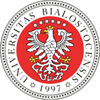Proszę używać tego identyfikatora do cytowań lub wstaw link do tej pozycji:
http://hdl.handle.net/11320/901| Tytuł: | Zygmunt I a senat koronny w latach 1506–1535 |
| Inne tytuły: | Sigismund I and the Crown Senate |
| Autorzy: | Brzozowski, Jacek |
| Słowa kluczowe: | Zygmunt I senat koronny rada królewska rada koronna rada książęca Bona Sforza Królowa Bona Royal Council Sigismund I Crown Senate Queen Bona Consilium Regini |
| Data wydania: | 2011 |
| Data dodania: | 19-mar-2014 |
| Wydawca: | Wydawnictwo Uniwersytetu w Białymstoku |
| Źródło: | Białostockie Teki Historyczne, T. 9, 2011, s. 11-39 |
| Abstrakt: | The Royal Council (Consilium Regini) was finally established as an all-state body in the middle of the XIV c. It consisted of the highest state dignitaries (Chancellor, Major-domo, Treasurer), landed dignitaries (Voivodes, Greater Castellans), the Archbishops of Gniezno and Lvov and Catholic bishops. At the beginning the Council’s functions were not legally regulated, but in practice it was an influential body in many spheres, e.g.: co-deciding about foreign policy, deciding about peace and war and about major appointments. Moreover, from 1422 the decision about minting was guaranteed to it by a statute. The royal court was also composed of the members of the Council. The monarch was eligible to appoint other members of the Council. Casimir IV Jagiellon made use of this privilege to liquidate political dominance of the so called “old” by introducing “the younger” (iuniores) – to lower offices. These steps led towards renewing of the elite in power. It is important as similar practice was applied during the reign of Sigismund I, allowing him to compose the Council according to his political idea. The composition of the group in power during the reign of Sigismund I underwent considerable alternations and modifications. Despite that we may point to a group of magnates, including Krzysztof Szydłowiecki, Mikołaj Szydłowiecki, Jan Łaski, Piotr Tomicki, whose position and influence were the most conspicuous. It could be noticed especially in the second half of the reign of Sigismund I the Old, when the political influence of Queen Bona was becoming stronger and stronger, the Senate was more divided, the knighthood more powerful and the king, due to his age and deteriorating health, kept losing influence on politics for the benefit of his wife. In the analyzed period one can observe establishment of two elite circles: one around Sigismund I, another around Queen Bona Sforza. It was beneficial neither from the point of view of the reasons of State nor the position of the monarch. |
| URI: | http://hdl.handle.net/11320/901 |
| DOI: | 10.15290/bth.2011.09.01 |
| ISSN: | 1425-1930 |
| Typ Dokumentu: | Article |
| Występuje w kolekcji(ach): | Artykuły naukowe (WSM) Białostockie Teki Historyczne, 2011, tom 9 |
Pliki w tej pozycji:
| Plik | Opis | Rozmiar | Format | |
|---|---|---|---|---|
| BTH_9_2011_Brzozowski (1).pdf | 286,68 kB | Adobe PDF | Otwórz |
Pozycja jest chroniona prawem autorskim (Copyright © Wszelkie prawa zastrzeżone)

